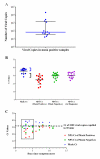Non-invasive adapted N-95 mask sampling captures variation in viral particles expelled by COVID-19 patients: Implications in understanding SARS-CoV2 transmission
- PMID: 33844696
- PMCID: PMC8041197
- DOI: 10.1371/journal.pone.0249525
Non-invasive adapted N-95 mask sampling captures variation in viral particles expelled by COVID-19 patients: Implications in understanding SARS-CoV2 transmission
Abstract
Infectious respiratory particles expelled by SARS-CoV-2 positive patients are attributed to be the key driver of COVID-19 transmission. Understanding how and by whom the virus is transmitted can help implement better disease control strategies. Here we have described the use of a noninvasive mask sampling method to detect and quantify SARS-CoV-2 RNA in respiratory particles expelled by COVID-19 patients and discussed its relationship to transmission risk. Respiratory particles of 31 symptomatic SARS-CoV-2 positive patients and 31 asymptomatic healthy volunteers were captured on N-95 masks layered with a gelatin membrane in a 30-minute process that involved talking/reading, coughing, and tidal breathing. SARS-CoV-2 viral RNA was detected and quantified using rRT-PCR in the mask and in concomitantly collected nasopharyngeal swab (NPS) samples. The data were analyzed with respect to patient demographics and clinical presentation. Thirteen of 31(41.9%) patients showed SARS-COV-2 positivity in both the mask and NPS samples, while 16 patients were mask negative but NPS positive. Two patients were both mask and NPS negative. All healthy volunteers except one were mask and NPS negative. The mask positive patients had significantly lower NPS Ct value (26) compared to mask negative patients (30.5) and were more likely to be rapid antigen test positive. The mask positive patients could be further grouped into low emitters (expelling <100 viral copies) and high emitters (expelling >1000 viral copies). The study presents evidence for variation in emission of SARS-CoV-2 virus particles by COVID-19 patients reflecting differences in infectivity and transmission risk among individuals. The results conform to reported secondary infection rates and transmission and also suggest that mask sampling could be explored as an effective tool to assess individual transmission risks, at different time points and during different activities.
Conflict of interest statement
The authors have declared that no competing interests exist.
Figures

References
-
- CDC (2020) Scientific Brief: SARS-CoV-2 and Potential Airborne Transmission.
Publication types
MeSH terms
Substances
LinkOut - more resources
Full Text Sources
Other Literature Sources
Medical
Miscellaneous

